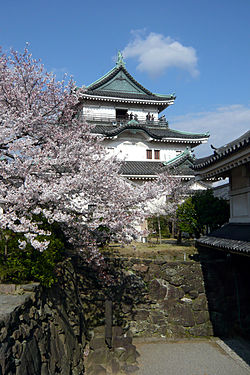Wakayama Castle
| Wakayama Castle | |
|---|---|
和歌山城 | |
| Wakayama, Wakayama-ken, Japan | |
 | |
| Coordinates | 34°13′39.46″N 135°10′17.84″E / 34.2276278°N 135.1716222°E |
| Type | Hirayamashiro (hilltop castle) |
| Height | Three stories |
| Site information | |
| Condition | The tenshu and some connected buildings were reconstructed using concrete in 1958. |
| Site history | |
| Built | 1585-1586 |
| Built by | Toyotomi Hidenaga |
| In use | 1586 to 1945 |
| Materials | Earth, stone, and wood |
| Demolished | Most of the castle during the Meiji Restoration, though the tenshu survived until its destruction from firebombing in 1945. |

Wakayama Castle (和歌山城, Wakayama-jō) is a
History

During the
Hideyoshi awarded the province to his younger brother, Toyotomi Hidenaga, who was already ruler of Yamato Province. Hidenaga close to keep Wakayama as the seat of his power in Kii Province, as its location was convenient for trade and strategically close to the former strongholds of Negoro-ji and the Saiga Ikki, who still had many sympathizers in the area. With the assistance of Tōdō Takatora, who was noted for castle architecture, he began rebuilding a small fortification on Torafusayama hill which had been a relic of Hatakeyama rule, with low stone walls aligned with the natural terrain, and the central bailey located next to the current central bailey area. Hidenaga appointed Kuwayama Shigeharu as castellan, and remained at Kōriyama Castle in Yamato. Following the Battle of Sekigahara, Tokugawa Ieyasu reassigned the province in 1600 to Asano Yoshinaga.[3]
Asano greatly expanded Wakayama Castle, constructing a three-story
The Asano were replaced as daimyō of Kishū Domain by
Kishū Domain eventually did provide two shogun.
In 1791 the US captains John Kendrick of the Lady Washington and William Douglas of the Grace visited Kushimoto, hoping to open a trading relationship with Japan. News was sent to Wakayama Castle, which sent troops. However, Kendrick and Douglas departed two days before the troops arrived. The result of this first visit of Americans to Japan was largely symbolic for the United States. For Japan it resulted in a new system of alarms and coastal patrols, increasing Japan's isolation under sakoku.[4][5][6]
In 1846, most of the castle was destroyed in a fire caused by lightning, but due to its special status, reconstruction of buildings including the tenshu was exceptionally permitted, and completed in 1850.
In 1901, the Honmaru and Ninomaru areas were opened to the public as Wakayama Park, and in 1931 it was designated as a National Historic Site.[3] The castle tower and all of the other Honmaru buildings were destroyed by the bombing of Wakayama by the US military during World War II. and the current tenshu was rebuilt in 1958 out of concrete and is open to the public as a symbol of the city and museum.[7]
Two original gates remain, one of which, the Okaguchi Gate, was designed a National [Important Cultural Property in 1957.[8]
Gallery
-
Wakayama Castle from the castle town
-
View from keep
-
O-hashi-rōka bridge and tenshu
-
Foundations of the Matsunomaru yagura
-
Okaguchi Gate (ICP)
-
Nishi-no-Maru Gardens
See also
Literature
- Benesch, Oleg and Ran Zwigenberg (2019). Japan's Castles: Citadels of Modernity in War and Peace. Cambridge: Cambridge University Press. p. 374. ISBN 9781108481946.
- De Lange, William (2021). An Encyclopedia of Japanese Castles. Groningen: Toyo Press. pp. 600 pages. ISBN 978-9492722300.
- Schmorleitz, Morton S. (1974). Castles in Japan. Tokyo: Charles E. Tuttle Co. ISBN 0-8048-1102-4.
- Motoo, Hinago (1986). Japanese Castles. Tokyo: Kodansha. p. 200 pages. ISBN 0-87011-766-1.
References
- ^ "和歌山城" [Wakayama-jō] (in Japanese). Agency for Cultural Affairs. Retrieved August 20, 2021.
- ^ "和歌山城西之丸庭園" [Wakayama-jō] (in Japanese). Agency for Cultural Affairs. Retrieved August 20, 2021.
- ^ ISBN 978-4311750403.(in Japanese)
- ISBN 978-0-06-202019-2.
- ISBN 978-0-275-95055-2. Retrieved 22 July 2012.
- ISBN 978-1-60780-008-8. Retrieved 22 July 2012.
- ^ Wakayama Castle Profile Retrieved August 25, 2016
- ^ "和歌山城岡口門" [Wakayama-jō Okaguchi-mon] (in Japanese). Agency for Cultural Affairs. Retrieved August 20, 2021.
External links
![]() Media related to Wakayama Castle at Wikimedia Commons
Media related to Wakayama Castle at Wikimedia Commons










